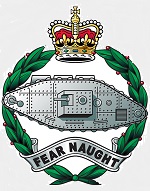Hobby Master HG3107 British Cruiser Tank, A27M Cromwell Mk. IV Tank - Brigadier Stanislaw Maczek, Command Tank, Polish 1st Armored Division, Northwest France, 1944 (1:72 Scale)
"The only way you can win a war is to attack and keep on attacking, and after you have done that, keep attacking some more."
- General George S. Patton Jr., January 1945
 The Cromwell tank was used by the British Army during the later stages of World War II. The Cromwell was ordered in 1941 and intended to replace the lightweight Crusader "cruiser" tank by being more heavily armoured, and, it was hoped, more survivable in battle. Its greater weight was to be driven by a 600-horsepower Rolls Royce Meteor engine, a derivative of Rolls Royce's line of aircraft engines. Initial models, however, were powered by other engines and were designated Cavaliers and Centaurs when they entered service in mid-1942. The first genuine Cromwells with Meteor engines entered service in early 1943.
The Cromwell tank was used by the British Army during the later stages of World War II. The Cromwell was ordered in 1941 and intended to replace the lightweight Crusader "cruiser" tank by being more heavily armoured, and, it was hoped, more survivable in battle. Its greater weight was to be driven by a 600-horsepower Rolls Royce Meteor engine, a derivative of Rolls Royce's line of aircraft engines. Initial models, however, were powered by other engines and were designated Cavaliers and Centaurs when they entered service in mid-1942. The first genuine Cromwells with Meteor engines entered service in early 1943.
The Cromwell tank weighed about 27 tons and had a top speed of 38 miles per hour and a range of between 80 and 170 miles, depending on the terrain. It was initially armed with a 75mm gun and two 7.92mm machine guns. The Cromwell's main assets were its speed, maneuverability, and ease of repair. It first entered battle in large numbers in mid-1944, during the Normandy Invasion and the ensuing campaign across northern France. From Normandy on, Cromwells and American Sherman tanks formed the backbone of British armored divisions. Like the Shermans, however, most Cromwells were outgunned by the more powerful German Panther and Tiger tanks. Cromwell tanks served in British armies until the war ended in Europe in mid-1945.
Shown here is a 1:72 scale replica of a British Cruiser Tank, A27M Cromwell Mk. IV command tank that was led by Brigadier Stanislaw Maczek, of the Polish 1st Armored Division, then deployed to northwest Europe during 1944.
Sold Out!
Dimensions:
Length: 3-1/2-inches
Width: 1-1/2-inches
Release Date: October 2009
 Historical Account: "Solidarity" - General Stanislaw Maczek (March 31st, 1892 - December 11th, 1994) was the most accomplished Polish tank commander of World War II. A veteran of World War I, the Polish-Ukrainian and Polish-Bolshevik Wars, he was the commander of Poland's only major armored formation during the September 1939 campaign, again commanded a Polish armored formation in France in 1940, and was commander of the famous Polish 1st Armored Division, and later of the First Polish Army Corps under Allied Command in 1942–1945.
Historical Account: "Solidarity" - General Stanislaw Maczek (March 31st, 1892 - December 11th, 1994) was the most accomplished Polish tank commander of World War II. A veteran of World War I, the Polish-Ukrainian and Polish-Bolshevik Wars, he was the commander of Poland's only major armored formation during the September 1939 campaign, again commanded a Polish armored formation in France in 1940, and was commander of the famous Polish 1st Armored Division, and later of the First Polish Army Corps under Allied Command in 1942–1945.
Towards the end of July 1944, the Polish 1st Armored Division was transferred to Normandy, where it was to prove its worth during the 1944 invasion of Europe. Attached to First Canadian Army, Maczek's men entered combat on August 8th during Operation Totalize. The division twice suffered serious bombings by Allied aircraft, yet achieved a brilliant victory against the Wehrmacht in the battles for Mont Ormel, Hill 262 and the town of Chambois. In this series of offensive and defensive operations, which came to be known as the Battle of Falaise, 14 German Wehrmacht and SS divisions were trapped in the huge Chambois pocket and destroyed. Maczek's division had the crucial role of closing the pocket at the escape route of those German divisions.
After this decisive battle, Maczek's Division continued to spearhead the Allied drive across the battlefields of France, Belgium, Netherlands and finally Germany. The Division's "moment of glory" came when its forces captured the German port of Wilhelmshaven and accepted the surrender of the entire garrison, including some 200 vessels of Hitler's Kriegsmarine.
General Maczek commanded the First Armored Division until the end of European hostilities and that year was promoted to major-general. After the capitulation of Germany he went on to command the Polish I Corps, then became commanding officer of all Polish forces in the United Kingdom until their demobilization in 1947.


